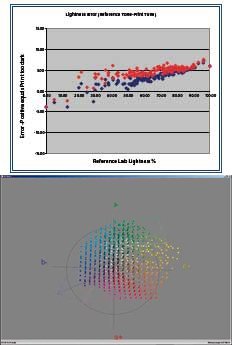articles/Printers/epson3800-page3
Epson Stylus Pro 3800 - part 3 of 1 2 3 4
by Mike McNamee Published

Velvet Fine Art Paper
This is a lightly textured, 260gsm, 48 micron calliper paper available as A3+ cut sheets only. For all practical purposes it could be considered neutral in colour with the slight addition of OBAs counteracting the natural creaminess of the base paper.
Using the matte Black ink option (which is called up automatically by the printer driver) the Dmax was 17% on the Lab brightness scale and 1.62 as a density value. This is fairly typical of a K3 ink result on this class of paper. The shadow detail was well differentiated using both the installed Epson profile and a bespoke one. Metamerism measured at 1.1 ΔE Lab (D65 to Tungsten), a low result, as might be expected with this paper/ink combination.
The gamut volume and average error were both improved by bespoke profiling in this case. The gamut volumes were less than those measured from the Epson Pro 4800 profile for the 4800 machine.
Colour ErrorOut of the box the 3800 hit an average error of 3.3ΔE2000, right on the value we measure for many hundreds of bespoke profiled printers. There was a generalised reduction in saturation error compared to the installed profile. The error in the Macbeth Light Skin swatch was a minuscule 0.7ΔE2000. The skin tones of the Epson, installed profiles were about 1° too yellow and 8% desaturated.
Overall the excellent results from this printer/paper combination are on a par with the 4800 despite the 4800's lower measured gamut volume.

Premium Glossy Photo paper
This is a 260gsm, 27 micron calliper, high-gloss paper, available in wide range of cut sheet and roll forms. The coating is relatively dead in the UV booth suggesting little or no optical brighteners. The base colour is about 4 Lab points cool (ie blue). The gamut volume for the Espon, installed profile was 843,130.
The overall colour error, using the installed profile was 5.5ΔELab/3.15ΔE2000, again better than the average we achieve with regular bespoke profiling. The shadow separation was excellent, just discernable down to 10 RGB points. The print was slightly darker than the aim value, to the tune of 2%. The Dmax was an impressive 2.28. The skin tones were about 5% desaturated and rotated a couple of degrees towards yellow.
For all practical purposes this would be considered a toprate print and would suffice for many proofing applications. The only quirk in the data was the greyscale neutrality which started at the base white (as it has to) but then wandered slowly away from paper neutral towards Lab neutral. The extent of this error was measured at 2ΔE at the 50% density. However, it was undetectable in a large monochrome print, presumably because the progression away from paper neutral was even and regularly spaced. The drift was not mimicked by the skin tones which drifted towards paper-white as usual. Metamerism was 1.6 ΔE Lab.
This then is an excellent paper for those who require a high gloss finish in a reasonably weighty paper - to most observers it looks and feels like a silver print.
Other papers
Epson have revamped their 'media performance guide', which now shows 14 paper variants for Photography and Fine Art. It includes four gloss/lustres, seven canvas and fine art media and three plain matte papers. Some are available in more than one weight, right up to 1.5mm board thickness.
Please Note:
There is more than one page for this Article.
You are currently on page 3
- Epson Stylus Pro 3800 page 1
- Epson Stylus Pro 3800 page 2
- Epson Stylus Pro 3800 page 3
- Epson Stylus Pro 3800 page 4
1st Published
last update 09/12/2022 14:53:54
More Printers Articles
There are 0 days to get ready for The Society of Photographers Convention and Trade Show at The Novotel London West, Hammersmith ...
which starts on Wednesday 15th January 2025




